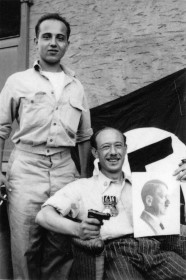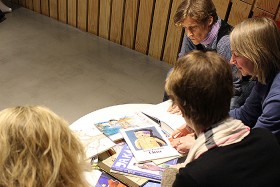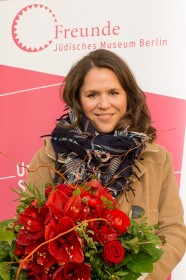Search Results for
"question"
Program Director Cilly Kugelmann on the Exhibition “NO COMPROMISES! The Art of Boris Lurie”

“As this image of Lurie with his brother-in-law Dino Russi from 1946 shows, the NO!art artists, in reclaiming the swastika symbol, robbed it of its symbolic value.” (Cilly Kugelmann)
Boris Lurie Art Foundation, New York
Our major retrospective dedicated to Boris Lurie opens 26 February 2016 (for more information see www.jmberlin.de/lurie/en). Blog editor Mirjam Bitter spoke with Cilly Kugelmann about the artist, his provocative work, and the possible impact today of the taboos that he broke throughout his career.
Mirjam Bitter: What is your view of Boris Lurie? What sort of a guy was he? What distinguished him as an artist?
Cilly Kugelmann: The man and the artist Boris Lurie was shaped by his experience of persecution and concentration camps under the Nazi regime. And yet, unlike other artists who faced similar experiences, I feel he cannot be described as a “Holocaust artist.” With the exception of some early drawings from 1946 and a few paintings from the late 1940s, he neither chronicled these events nor sought to interpret the Holocaust artistically in his work.
Then what role did the Holocaust play in Lurie’s work? (more…)
An Interview with Barbara Rösch about “Recommended Reading on National Socialism and the Holocaust”

Members of the reading circle © Jewish Museum Berlin, photo: Christine Marth
A German-language brochure listing “Recommended Reading on National Socialism and the Holocaust” was recently made available for download from our website as a PDF. Over the last few years several museum employees read widely on the topic, shared their opinions and then made this selection. Dr. Barbara Rösch of our Education Department talked to me about what was involved. She is a member of the reading circle and also worked for a time at the Universities of Potsdam and Leipzig as an elementary school teacher trainer. In addition to her work at the Jewish Museum Berlin she is currently writing a book about everyday racism in elementary schools.
Dear Barbara, countless books about National Socialism and the Holocaust are available for children and young people. How did you go about making a selection?
Our work is oriented primarily to the needs of teachers, who regularly ask us to make recommendations and indeed seem almost to think that we must. We therefore bear in mind the so-called “classics” that are read in German classrooms as well as new publications, books written from a non-German perspective, and books that touch upon hitherto neglected themes, such as the hakhshara movement. (more…)
On Identifying Museum Visitors and What Moves Them

The ten-millionth visitor Paula Konga in November 2015 © Jewish Museum Berlin, photo: Svea Pietschmann
Gleeful excitement in the museum lobby, for we are greeting our ten-millionth visitor since the opening in 2001, and we are all ears. “It’s my day off and I want to take the opportunity to revisit the permanent exhibition,” the 33-year-old Berliner Paula Konga tells us. An architect by profession, she is particularly interested in Daniel Libeskind’s design of the museum. “The building is well worth visiting more than once, also for Berliners.” No sooner have we handed over a bouquet of flowers and a one-year-membership in the Friends of the Jewish Museum Berlin Association than our guest of honor vanishes into the ramified spaces of the Libeskind Building (further information about the Libeskind Building can be found on our website).
Next, a group of Italian schoolchildren pushes past me, another museum visitor asks me to switch his audio guide to French, and a group of British teenagers mills about in search of a young man in a red cap. The seething mass sets me thinking: What actually moves you here, in the Jewish Museum Berlin? (more…)


